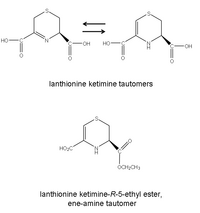Appearance white powder | ||
 | ||
Lanthionine ketimine (3,4-dihydro-2H-1,3-thiazine-3,5-dicarboxylic acid) is a naturally occurring sulfur amino acid metabolite found in the mammalian brain and central nervous system (CNS).[1][2] Synthetic derivatives of lanthionine ketimine have been documented to possess various biological activities suggesting that the molecules are plausible lead candidates for the treatment of neurodegenerative disease.[3]
Contents
Background
Lanthionine ketimine was documented as a natural metabolite as early as 1983 by Professor Dorianno Cavallini, who published regarding its synthesis and chemical properties. Cavallini and others showed that lanthionine ketimine forms from alternative reactions of the transsulfuration pathway enzyme cystathionine-β-synthase, which normally condenses the amino acids homocysteine and serine to form cystathionine. In an alternate pathway, cysteine and serine (or two equivalents of cysteine) condense to form lanthionine. The product of these transformations is lanthionine or cystathionine ketimine, respectively.
Additional sources of lanthionine ketimine have been proposed. Lanthionine ketimine also binds the brain protein lanthionine synthase-like protein-1 (LANCL1), a glutathione-binding protein of uncertain function. It has been hypothesized, but not proved, that LANCL1 might catalyze formation of glutathione-lanthionine conjugates in a pathway leading to lanthionine ketimine.
Lanthionine ketimine and a synthetic, cell-penetrating ester derivative called lanthionine ketimine-5-ethyl ester (LKE) reportedly potentiate growth factor-dependent extension of neuron processes (neurites) in cell culture. This neurotrophic activity may occur through interaction of lanthionine ketimine with a protein called collapsin response protein-2 (CRMP2, also known as dihydropyrimidinase-like protein-2 or DPYSL2). Normally CRMP2 functions to promote or inhibit neurite growth. Lanthionine ketimine interacts with CRMP2 in affinity proteomics experiments and alters CRMP2 binding to other proteins in brain lysate preparations.
Beside its neurotrophic effects, lanthionine ketimine and its ester LKE reportedly protect neurons against oxidative stress and inhibit the activation of microglia (brain macrophages) triggered by exposure to inflammatory cytokines. Administration of LKE to the SOD1G93A mouse model of the motor neuron disease amyotrophic lateral sclerosis (ALS), reportedly slows progression of paralytic disease in this mouse.
Derivatives of lanthionine ketimine have been patented as experimental therapeutics to treat neurological diseases and diseases possessing a pathological inflammatory component.
Preparation
Lanthionine ketimine or its ethyl esters can be synthesized by condensation of cysteine derivatives (e.g. L-cysteine-ethyl ester hydrochloride) with 3-bromopyruvate or 3-bromopyruvate derivatives in water, followed by filtration and thorough aqueous washing of the precipitate. When dried, the precipitate can be resolubilized in aqueous medium by slow titration with NaOH or other base.
